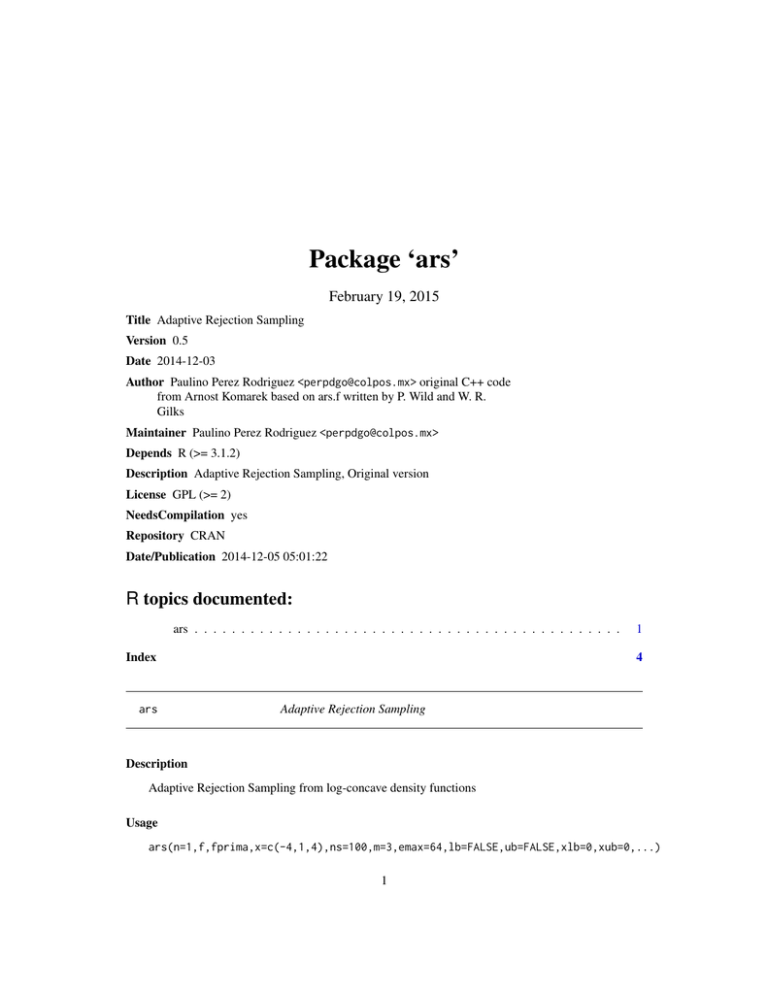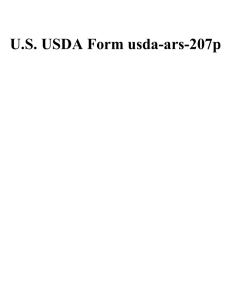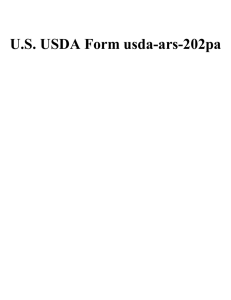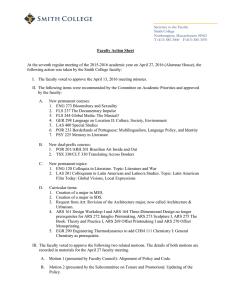Package `ars`
advertisement

Package ‘ars’
February 19, 2015
Title Adaptive Rejection Sampling
Version 0.5
Date 2014-12-03
Author Paulino Perez Rodriguez <perpdgo@colpos.mx> original C++ code
from Arnost Komarek based on ars.f written by P. Wild and W. R.
Gilks
Maintainer Paulino Perez Rodriguez <perpdgo@colpos.mx>
Depends R (>= 3.1.2)
Description Adaptive Rejection Sampling, Original version
License GPL (>= 2)
NeedsCompilation yes
Repository CRAN
Date/Publication 2014-12-05 05:01:22
R topics documented:
ars . . . . . . . . . . . . . . . . . . . . . . . . . . . . . . . . . . . . . . . . . . . . . .
Index
ars
1
4
Adaptive Rejection Sampling
Description
Adaptive Rejection Sampling from log-concave density functions
Usage
ars(n=1,f,fprima,x=c(-4,1,4),ns=100,m=3,emax=64,lb=FALSE,ub=FALSE,xlb=0,xub=0,...)
1
2
ars
Arguments
n
sample size
f
function that computes log(f(u,...)), for given u, where f(u) is proportional to the
density we want to sample from
fprima
d/du log(f(u,...))
x
some starting points in wich log(f(u,...) is defined
ns
maximum number of points defining the hulls
m
number of starting points
emax
large value for which it is possible to compute an exponential
lb
boolean indicating if there is a lower bound to the domain
xlb
value of the lower bound
ub
boolean indicating if there is a upper bound to the domain
xub
value of the upper bound bound
...
arguments to be passed to f and fprima
Details
ifault codes, subroutine initial
1. 0:successful initialisation
2. 1:not enough starting points
3. 2:ns is less than m
4. 3:no abscissae to left of mode (if lb = false)
5. 4:no abscissae to right of mode (if ub = false)
6. 5:non-log-concavity detect
ifault codes, subroutine sample
1. 0:successful sampling
2. 5:non-concavity detected
3. 6:random number generator generated zero
4. 7:numerical instability
Value
a sampled value from density
Author(s)
Paulino Perez Rodriguez, original C++ code from Arnost Komarek based on ars.f written by P. Wild
and W. R. Gilks
ars
3
References
Gilks, W.R., P. Wild. (1992) Adaptive Rejection Sampling for Gibbs Sampling, Applied Statistics
41:337–348.
Examples
library(ars)
#Example 1: sample 20 values from the normal distribution N(2,3)
f<-function(x,mu=0,sigma=1){-1/(2*sigma^2)*(x-mu)^2}
fprima<-function(x,mu=0,sigma=1){-1/sigma^2*(x-mu)}
mysample<-ars(20,f,fprima,mu=2,sigma=3)
mysample
hist(mysample)
#Example 2: sample 20 values from a gamma(2,0.5)
f1<-function(x,shape,scale=1){(shape-1)*log(x)-x/scale}
f1prima<-function(x,shape,scale=1) {(shape-1)/x-1/scale}
mysample1<-ars(20,f1,f1prima,x=4.5,m=1,lb=TRUE,xlb=0,shape=2,scale=0.5)
mysample1
hist(mysample1)
#Example 3: sample 20 values from a beta(1.3,2.7) distribution
f2<-function(x,a,b){(a-1)*log(x)+(b-1)*log(1-x)}
f2prima<-function(x,a,b){(a-1)/x-(b-1)/(1-x)}
mysample2<-ars(20,f2,f2prima,x=c(0.3,0.6),m=2,lb=TRUE,xlb=0,ub=TRUE,xub=1,a=1.3,b=2.7)
mysample2
hist(mysample2)
Index
∗Topic distribution
ars, 1
ars, 1
4


